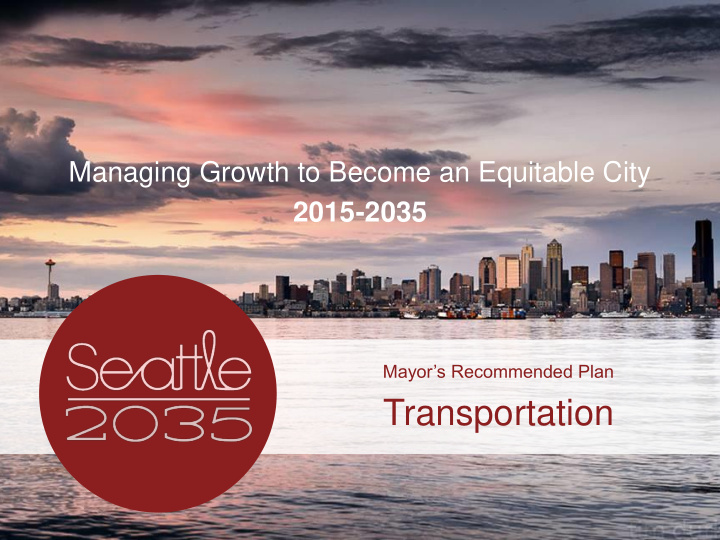



Managing Growth to Become an Equitable City 2015-2035 Mayor’s Recommended Plan Transportation
Presentation overview • Planning context for Transportation Element • Outline of Transportation Element and main goals • Summary of key issues • Questions and discussion 2
Council Review of Plan Comp Plan Topic Council Committee Date Overview PLUZ May 17 Growth Strategy PLUZ June 7 Land Use Growth Strategy PLUZ June 21 Transportation Sustainability and Transportation June 21 Public Hearing PLUZ June 27 Housing Affordable Housing, Neighborhoods and July 6 Neighborhood Planning Finance Capital Facilities, Economic Development, Civil Rights, Utilities, Economic July 12 Arts & Culture Development & Arts Community Well-Being Human Services and Public Health July 13 Schools and Growth Education, Equity and Governance July 20 Parks, Open Space and Recreation Parks July 21 Environment Energy and Environment TBD Utilities
Planning Context • Comp Plan is policy document • Vision for how we will manage growth over the next 20 years • Growth Projections • Urban Village Strategy
Changes in Seattle since the last major update • Added 51,000 housing units and 58,000 jobs since 2004 • Expanded transit (light rail and more bus hours) • Ride sharing • City’s commitment to be carbon neutral • Updated Vision 2040 and Countywide Planning Policies • New growth assumptions • Affordable housing crisis • City’s increased emphasis on race and social equity
What’s in the Plan Growth Strategy Economic Neighborhood Planning (previously Urban Development (previously Neighborhood Village) Planning A) Environment Land Use Container Port Parks and Open (no changes) Transportation Space Shoreline Areas Housing (no changes) Arts and Culture Neighborhood Plans (previously Cultural Capital Facilities Resources) (previously Neighborhood Utilities Planning B, no changes) Community Well- Being (previously Human Development)
Transportation Element Key Themes Use right-of- Invest in travel Ensure goods way for multiple options movement purposes 7
Outline of Transportation Element Sub-chapters • Integrating Land Use and Transportation • Make the Best Use of the Streets We Have • Transportation Options • Transportation Effects on the Environment • Support a Vibrant Economy • Safety • Connecting to the Region • Operating and Maintaining the Transportation System • Measuring Level of Service • Funding
Issue #1: Right-of-way (ROW) allocation • Community interest in considering how different modes could be prioritized • Action in Climate Action Plan • Consistent with emphasis in Move Seattle on integrating modes • Recognizes community interest in considering all functions of the public right-of-way, including access (not just mobility) • Plan identifies new framework for considering how ROW allocation decisions should be made
ROW allocation: zones 10
ROW allocation: functions 11
Issue #2: Level of service (LOS) • City has had a LOS measure focusing on vehicles since the 1994 Comprehensive Plan • Community members expressed support for a more multi- modal LOS measure • Also strongly supported in the Multi-County planning policies (Vision 2040) • New LOS measure focuses on “mode share” in the pm peak hour (3:00 to 6:00), when the transportation system is most congested • Measure more consistent with the overall land use and transportation goals in the plan • Plan focuses on growth occurring in urban centers and villages, served by a multi-modal transportation system • Important to ensure goods can move throughout the city
Level of service: now and proposed 13
Level of service: why mode share? 200 PEOPLE CAN TRAVEL… in 177 cars 3 buses 1 light rail train on their bikes
Level of service: why mode share?
Level of service: travel trends
Level of service: why mode share? Shift in mode share results in moving the same number of people in fewer vehicles, thus improving overall throughput.
Issue #3: Safety • Previous Transportation Element was fairly silent on safety • Updated goals and policies recognize strong community interest in increasing the safety of the transportation system • Aligns Transportation Element with Vision Zero • Target of zero fatalities and serious injuries by 2030
Issue #4: Transportation options/modal plans • Modal plans completed (or in process) since 2004 Comprehensive Plan update • Recommended plan includes all modal plan network maps • Provides public with information about where investments are planned, and how they tie to where growth will occur
Issue #5: Updating supporting information • Updated the Funding section to incorporate Move Seattle and Prop 1 levies • Updated all inventory and map information in Transportation Appendix to meet GMA requirements
Equity in Transportation Selected equity-related policies Transportation Element: • Consider the income, age, ability, vehicle ownership patterns of populations throughout the city in developing transportation systems to that all residents, especially those most in need, have access to a wide range of travel options. • Prioritize transit investments on the basis of ridership demand, service to populations heavily reliant on transit, and opportunities to leverage funding. • Look for innovative ways to create training, youth employment, and living-wage opportunities for marginalized populations in the construction and major maintenance of transportation facilities.
Questions? tom.hauger@seattle.gov | (206) 684-8380 kevin.oneill2@seattle.gov | (206) 386-4556 http://2035.seattle.gov www.seattle.gov/transportation
Recommend
More recommend